The Economics and Statistics Division maintains archives of previous publications for accountability purposes, but makes no updates to keep these documents current with the latest data revisions from Statistics Canada. As a result, information in older documents may not be accurate. Please exercise caution when referring to older documents. For the latest information and historical data, please contact the individual listed to the right.
<--- Return to Archive
For additional information relating to this article, please contact:
July 21, 2022CANADIAN HOUSING SURVEY, 2021 Results from the Canadian Housing Survey for 2021 report on conditions for homebuyers, distinguishing first-time homebuyers (those purchased within the 5 years) from non-first-time homebuyers and renters. The data reports on the type of structure in which a respondent household lives, the age and family structure of respondents and their satisfaction with their dwelling and neighbourhood. The data are available for provinces, cities as well as for different sizes of community within each province.
The 2021 housing survey reports on conditions from January to June 2021, during which there were extraordinary government income support programs in place. The income from these COVID-related programs may alter whether families were in core housing need (particularly based on spending 30% or less of income on housing) or reported financial difficulties.
In Nova Scotia, there were 416,600 households, of which 29.9% were couple families without children, 29.7% were one-person households, 22.9% were couple families with children and 8.3% were lone parent families. The remaining 9.3% of households were in other families (4.7%) or in non-family households with two or more persons (4.6%). Compared with national averages, Nova Scotia had a higher shares of couple families without children as well as lone parent families. Nova Scotia also reported the second smallest share of households who were couple families with children.
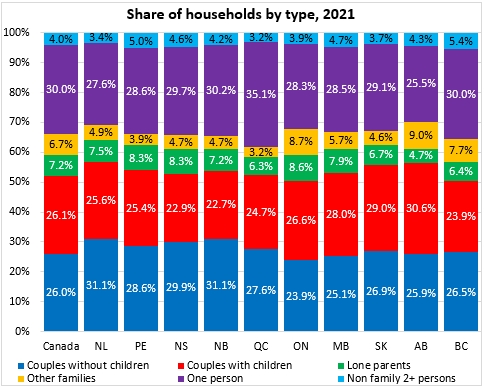
The portion of couple families without children among households was notably higher in Nova Scotia's rural areas (as it was in Canada's rural areas). In Nova Scotia's small population centres, the share of one-person households and lone-parent families was higher (and the share in couple families with children was lower).

Renters made up 31.2% of Nova Scotia's households while 68.8% were homeowners. Compared with the national average, Nova Scotia had a slightly larger share of owner households and slightly lower share of renter households.
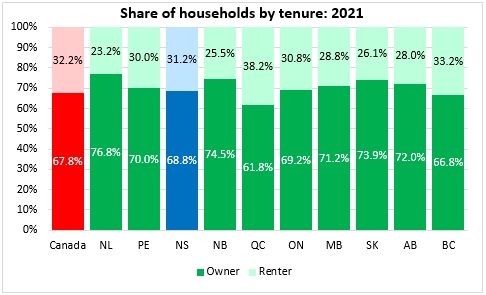
In Atlantic Canada, a much larger share of households live in rural areas, including 41.9% in Nova Scotia (national average: 18.3%). Of Nova Scotia's rural households, the large majority were homeowners. In smaller population centres and large urban areas, the share of home ownership and rental tenure was more balances (though ownership was still larger). Note: Nova Scotia has no 'medium urban centres' under Statistics Canada's definitions.
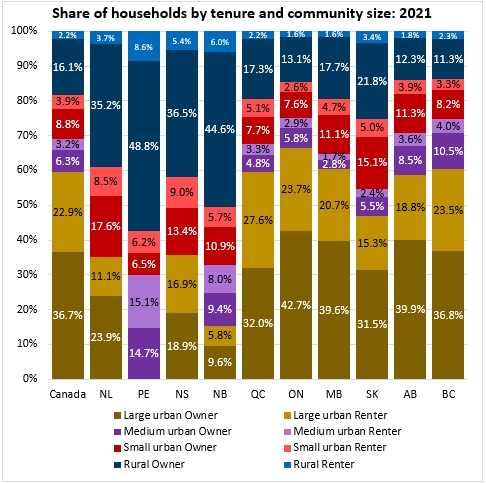
The housing survey asked respondents about their difficulty or ease in meeting financial needs. In 2021, 34.7% of Nova Scotia households reported that meeting financial needs was 'easy' or 'very easy' while 21.1% reported that meeting financial needs was 'difficult' or 'very difficult'. Across Canada, financial difficulties were lowest in Quebec and highest in Alberta. Easy financial conditions were reported most frequently in Quebec and least in Alberta.
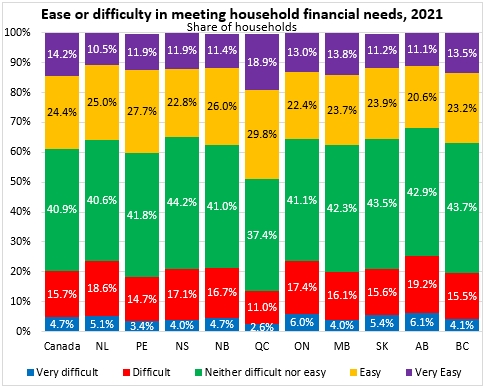
Financial difficulties were more prevalent in Nova Scotia's larger urban populations and less prevalent in smaller centres and rural areas. Across Canada, rural populations reported greater financial difficulties while large urban populations reported the least.

Core housing need is defined as the portion of the population that experience at least one of:
- unaffordability (spending >30% of income on housing)
- inadequacy (requiring major repairs)
- unsuitability (insufficient bedrooms/size for family composition)
The majority of those in core housing need are in this situation because of affordability. With larger transfer and income support programs during COVID-19, the share of Nova Scotia's households in core housing need fell from 11.0% in 2018 to 9.9%. Across Canada, core housing need fell from 11.3% of households in 2018 to 9.8% of households in 2021. There were improvements in all provinces. British Columbia continued to report the largest share of households in core housing need while the lowest shares of households in core housing need continued to be in Quebec and New Brunswick.
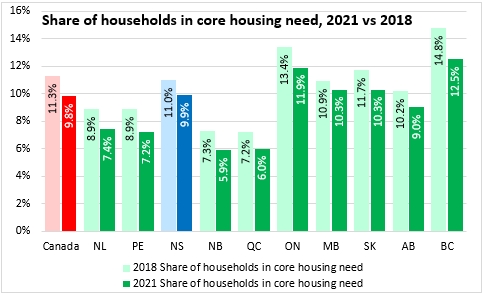
Core housing need was higher in Nova Scotia's larger urban areas and smaller population centres than in rural areas. However, from 2018 to 2021, the share of households in core housing need fell for large urban areas and smaller centres while it rose in Nova Scotia's rural areas. Across Canada, the share of households in core housing need improved for all sizes of community and the share of households in core housing need was positively related to population size (core housing need rises with larger population centres).
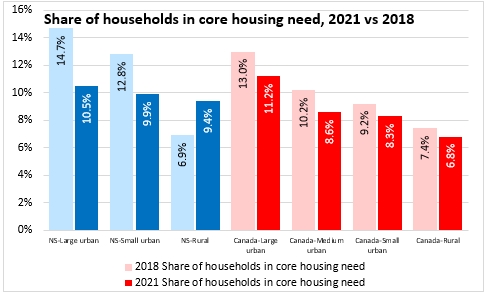
The share of persons (as opposed to households) in core housing need was lower for Nova Scotia and all provinces. This suggests a concentration of core housing need among households that are smaller than average (such as one-person households).
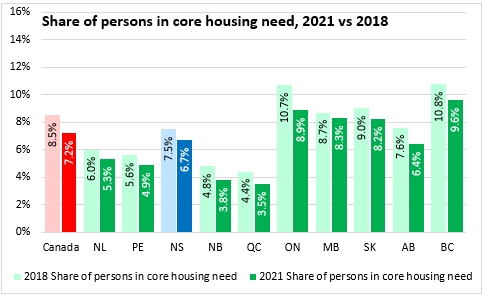
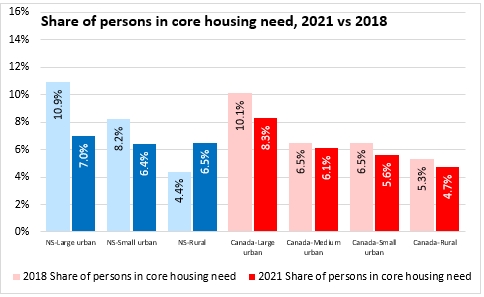
The housing survey also assesses satisfaction with dwelling and with neighbourhood. In Nova Scotia, satisfaction with dwellings and with neighbourhoods was higher in smaller centres and rural areas. Nova Scotians in large urban areas reported less satisfaction with their dwellings and with their neighbourhoods.

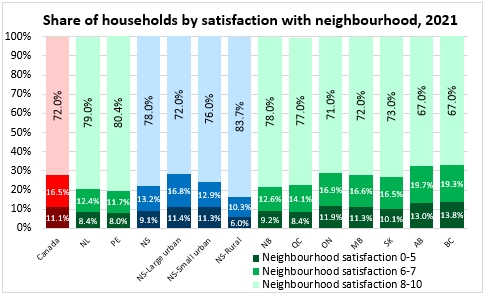
In the 5 years prior to the housing survey, 32% of Nova Scotia's households reported moving. Of these, 19.4% moved within the same community while 11.6% had moved to another community within Canada. Only 1.0% of respondents in Nova Scotia had moved from an international location. Moving was most frequent among British Columbia's households and least frequent among households in Newfoundland and Labrador.
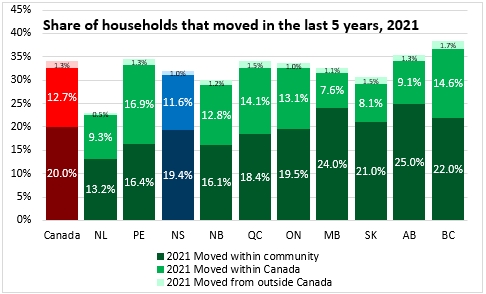
When asked for reasons behind moving, the largest portion of Nova Scotia households cited upgrades to a larger or better quality dwelling. Moving to a more desirable neighbourhood and reducing housing costs were also frequently cited reasons for moving. Between 2018 and 2021, there were notable increases in the portion of moving households that cited being forced by landlords/governments/banks as well as the portions that wanted to be closer to family, that had personal health reasons and that were moving to become a homeowner.
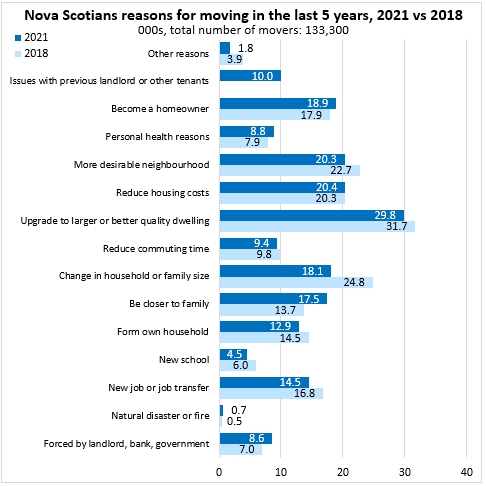
Source:
<--- Return to Archive